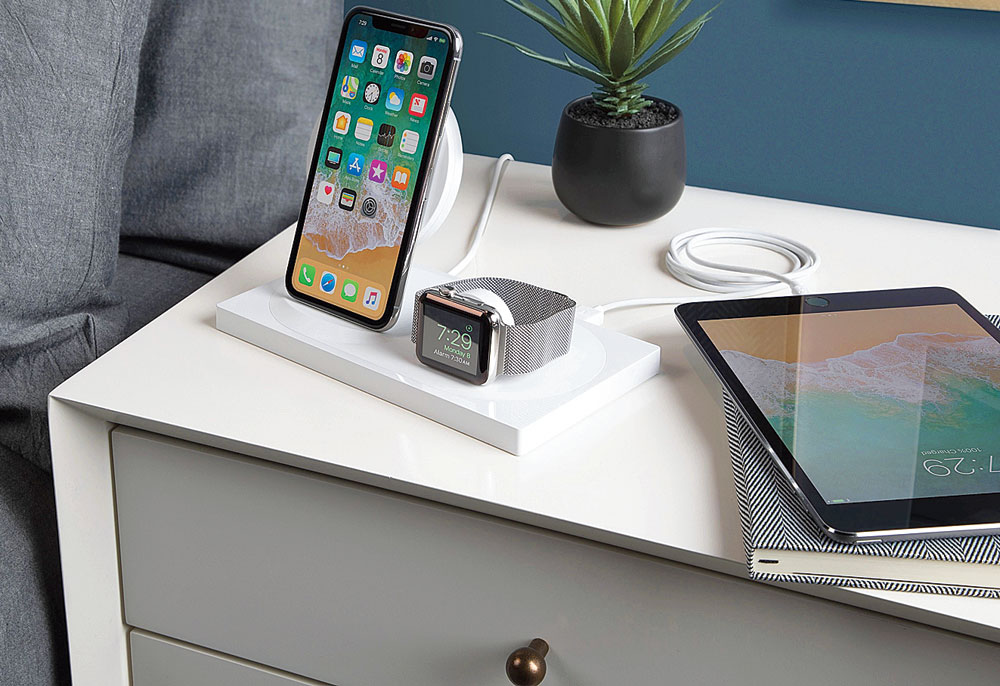Besides getting bigger, smartphones keep getting — for lack of a better word — glassier. From front to back, the bodies of many of the newest smartphones are composed of glass.
The trend is not part of a broad conspiracy to make you shatter your phone so that you buy a new one. Instead, glass lets energy pass through the phone so that it can be charged wirelessly. The technology relies on magnetic induction, which involves using an electrical current to generate a magnetic field, creating voltage that powers the phone without your plugging a wire into it.
People typically need accessories from companies like Samsung, Mophie and Anker — which generally look like mats and stands that you can set your phone on — to wirelessly power up. And while you don’t have to plug a cable into the phone, the accessories themselves have to be hooked up to a power outlet.
There’s a trade-off, too: Wireless charging is less efficient at transferring energy than a wire, and is thus slower at refilling a battery.
So what’s the point?
Charlie Quong, vice-president of product development for Mophie, said placing wireless chargers in areas where people spent a lot of time — like their bedroom, car and office — could enable them to top off their phones more frequently by removing the hassle of plugging in.
The products help people “get charged throughout their day without having to deliberately park their phone down,” Quong said. “It’s really, really convenient.”
As a longtime sceptic of wireless chargers, I was eager to find a useful application for the technology. So I scattered the chargers around the focal points of my daily routine.
In the bedroom
Two types of wireless chargers can be placed on a bedside table: pads and stands.
The pad is a disc, and you lay your phone down on it. The stand keeps your phone upright so that the screen faces you while it charges.
The stand is convenient. It elevated my phone at an angle to turn the phone into an alarm clock — with a quick poke at the screen, I could glance at the time, disable an alarm or look at a calendar alert. At night when the lights were off, setting the phone on the dock was easier than fumbling around for a wire to plug in. And the slower charging didn’t matter, because I was asleep.
The pad was less useful. With the phone lying flat, I had to remove it from the charger whenever I wanted to check it.
In the office
A wireless charging pad or stand can also be placed on an office desk. The idea is to quickly set your phone down on the charger whenever you return to the table.
Wireless charging isn’t beneficial in an office environment, assuming you care about speed and productivity.
The other downside in the office is that you can’t easily use the phone to write a message without removing it from the charger. With a cord, you can do all your important tasks while staying plugged in.
In the living room
You could place a charging pad on a TV stand or end table for guests to replenish their phones when they come over. It’s not only convenient and hospitable, but it also looks less tacky than dangling cords all over your common areas.
Unless all your friends and members of your family are tech enthusiasts, it’s unlikely that they all have phones capable of wireless charging. It’s a safer bet to leave a few power cables out; if you want the wires to look less messy, you can organise them with cheap magnetic clips.
In the car
Many cars now include CarPlay or Android Auto, the infotainment systems offered by Apple and Google, which mirror your phone’s maps and apps on the screen of your car’s console. Though some cars can connect with CarPlay and Android Auto wirelessly, many still require a wire to connect your phone to the infotainment systems. The wire simultaneously charges your phone, so why bother with a charging mount?










